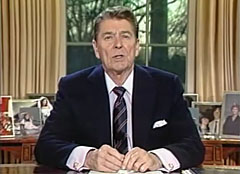1981

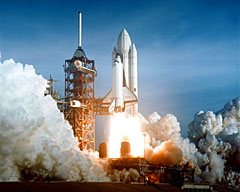
NASA Public Domain Image
April 12, 1981
First Space Shuttle Launch
First Reusable Spacecraft
The first manned mission of the Space Transportation System (STS-1), Columbia, is launched. This first flight carries a crew of two. They are mission commander John W. Young and pilot Robert L. Crippen. This mission, as well as the next three, will be a test flight to try out the spacecraft's systems. Columbia successfully orbits the Earth 36 times and returns home as the world's first reusable spacecraft.

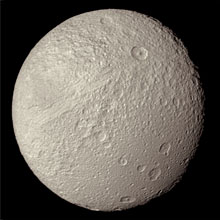
NASA Public Domain Image
August 25, 1981
Voyager 2 Arrives at Saturn
The Voyager 2 spacecraft arrives at Saturn and begins sending back images of the planet and its moons. The probe passes within 63,000 miles (101,000 kilometers) of the ringed planet. In addition to the planet, Voyager 2 photographs the moons Hyperion, Enceladus, Tethys, and Phoebe as well as the more recently discovered Helene, Telesto and Calypso. It also discovers 10 new moons and two new rings.
1982

March 1, 1982
First Venus Soil Samples
The Soviet Venera 13 spacecraft lands on the planet Venus and provides the first scientific analysis of the Venusian soil. The lander also captures a few images and functions for 127 minutes before shutting down due to the intense heat and pressure on the planet's surface.

Public Domain Image

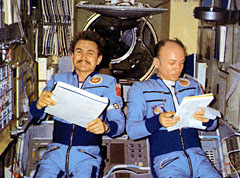
Public Domain Image
May 13, 1982
New Space Endurance Record
Soviet cosmonauts Anatoli N. Berezovoi and Valentin V. Lebedev are launched in Soyuz T-5 to rendezvous with Salyut 7 and become the first team to inhabit the space station. They return to Earth in Soyuz T-7, setting a new duration record of 211 days.

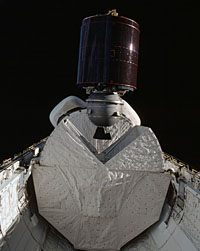
NASA Public Domain Image
November 11, 1982
First Operational Space Shuttle Mission
The Space Shuttle Columbia begins its fifth mission into space. This is the first fully operational Space Shuttle mission. STS-5 launches with a four-member crew on a five day mission that deploys two commercial communication satellites. It also performs a number of scientific experiments including three student-designed experiments.
1983

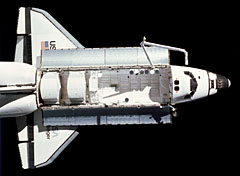
NASA Public Domain Image
April 4, 1983
Maiden Voyage of Challenger
America's second Space Shuttle, Challenger, embarks on its first mission into space. The STS-6 mission includes America's first space walk in nine years. The mission deploys the first Tracking and Data Relay Satellite, TDRS-1, into orbit before landing at Edwards Air Force Base in California.

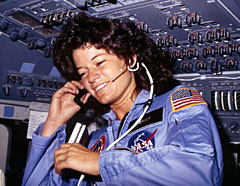
NASA Public Domain Image
June 19, 1983
First American Woman in Space
Astronaut Sally K. Ride becomes the first American woman to travel into space on Space Shuttle Challenger mission STS-7. She is the third woman in space overall, after USSR cosmonauts Valentina Tereshkova in 1963 and Svetlana Savitskaya in 1982.
1984

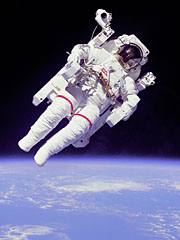
NASA Public Domain Image
February 3, 1984
First Untethered Spacewalk
Astronaut Bruce McCandless takes the first untethered space walk using the new Manned maneuvering Unit (MMU). Over the next few days, McCandless and fellow astronaut and Robert L. Stewart perform a number of tests with the MMU to practice for a future satellite capture mission. It is later used to capture the Solar Maximum satellite and to bring it into the shuttle's payload bay for repairs and servicing.

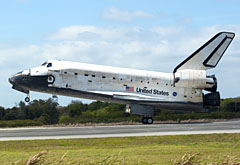
NASA Public Domain Image
August 30, 1984
Maiden Voyage of Discovery
The third orbiter of the American Space Shuttle fleet, Discovery, lifts off for its maiden voyage into space. During mission STS-41D, the six-member crew lunches three communications satellites and tests a new solar panel array. Discovery will eventually launch the Hubble Space Telescope and conduct the second and third Hubble service missions.
1985

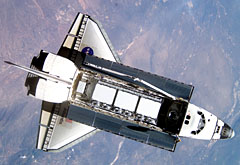
NASA Public Domain Image
October 3, 1985
Maiden Voyage of Atlantis
Shuttle Atlantis, the forth orbiter in America's Space Shuttle fleet, begins its first mission in space. During mission STS-51J, the five-member crew performs a number of classified missions of the U.S. Department of Defense. During its operational lifetime, Atlantis will orbit the earth a total of 4,848 times, traveling nearly 126,000,000 miles (203,000,000 kilometers) or more than 525 times the distance from the Earth to the Moon.
1986

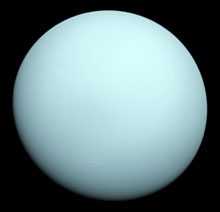
NASA Public Domain Image
January 24, 1986
Voyager 2 Arrives at Uranus
Voyager 2 arrives at the planet Uranus, giving us our first closeup views of the giant ice planet. The spacecraft passes within 50,600 miles (81,500 kilometers) of the planet's cloud tops. The images reveal a mostly featureless blue-green sphere composed mainly of hydrogen and helium along with ices such as water, ammonia, and and methane. Voyager 2 also discovers 11 new moons and studies the planet's unique atmosphere, caused by its axial tilt of 97.8 degrees.

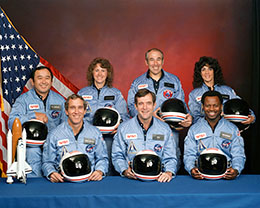
NASA Public Domain Image
January 28, 1986
Space Shuttle Challenger Tragedy
The space shuttle Challenger explodes shortly after liftoff of mission STS-51L, resulting in the loss of the spacecraft and her seven-member crew. The accident seems especially tragic because of Christa McAuliffe, the first civilian to fly into space. She is part of the Teacher in Space program and was to hold a number of classes for school children while in orbit. The accident is caused by unusually cold temperatures and a faulty o-ring seal in one of the solid rocket boosters. NASA grounds the entire space shuttle fleet until safety updates can be made.

January 28, 1986
President Reagan's Challenger Speech
Following the tragic loss of seven American astronauts aboard the Space Shuttle Challenger, President Ronald W. Reagan delivers a solemn and heart-felt speech honoring the crew of mission 51-L. In his speech, the President acknowledges the great loss not only to the families of the brave astronauts but also to the nation and the thousands of school children who gathered to watch teacher Christa McAuliffe begin her historic mission as the first civilian in space.

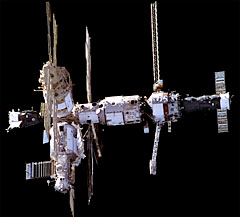
Wikipedia Public Domain Image
February 20, 1986
Mir Station Launched
The first module of the Mir space station is successfully launched and placed into Earth orbit. Mir becomes the first modular space station in orbit. It hosts a number of successful Russian and American missions and remains in orbit until 2001 when it comes crashing down into the Pacific Ocean.
1988

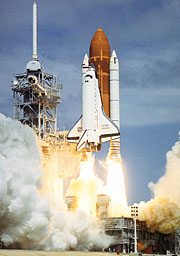
NASA Public Domain Image
September 29, 1988
Space Shuttle Returns to Flight
The space shuttle Discovery launches from the Kennedy space center on mission STS-26, marking the shuttle's return to flight two and a half years after the Challenger accident. NASA redesigned the solid rocket boosters to make them safer. They also made a number of changes to operational procedures to prevent the communications breakdown that contributed to the Challenger tragedy.
1989

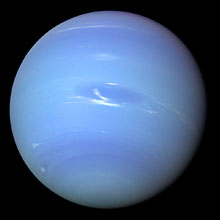
NASA Public Domain Image
August 25, 1989
Voyager 2 Arrives at Neptune
The Voyager 2 spacecraft arrives at Neptune, giving us our first close-up views of the blue planet and its moons. The spacecraft passes within 3,000 miles (4,950 kilometers) of Neptune's north pole. Scientists expect the planet to be a blue, featureless sphere much like Uranus. Instead, they are surprised to discover a curious dark spot and a number of dynamic, white cloud features. The Voyager spacecraft also discovers previously unknown Neptunian rings and confirms six new moons.
1990

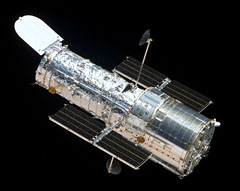
NASA Public Domain Image
April 24, 1990
Launch of Hubble Space Telescope
Space Shuttle Discovery lifts off for mission STS-31, carrying the Edwin P. Hubble Space Telescope (HST). The telescope is successfully deployed, but is found to contain a seriously flawed primary mirror resulting in fuzzy images. A future Space Shuttle mission will install a corrective lens which will solve the problem and make Hubble the most powerful telescope ever created.

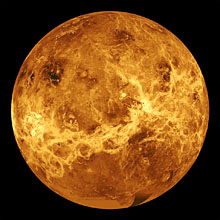
NASA Public Domain Image
August 10, 1990
Magellan Arrives at Venus
U.S. spacecraft Magellan arrives at the planet Venus where is begins mapping the planet's cloud-covered surface using radar. Magellan uses synthetic aperture radar to penetrate the thick cloud layers and create a detailed map of nearly the entire surface of Venus. It also measures the planetary gravitational field. Magellan is the first planetary exploration spacecraft to be launched by a space shuttle when it is deployed by Atlantis on mission STS-30.





